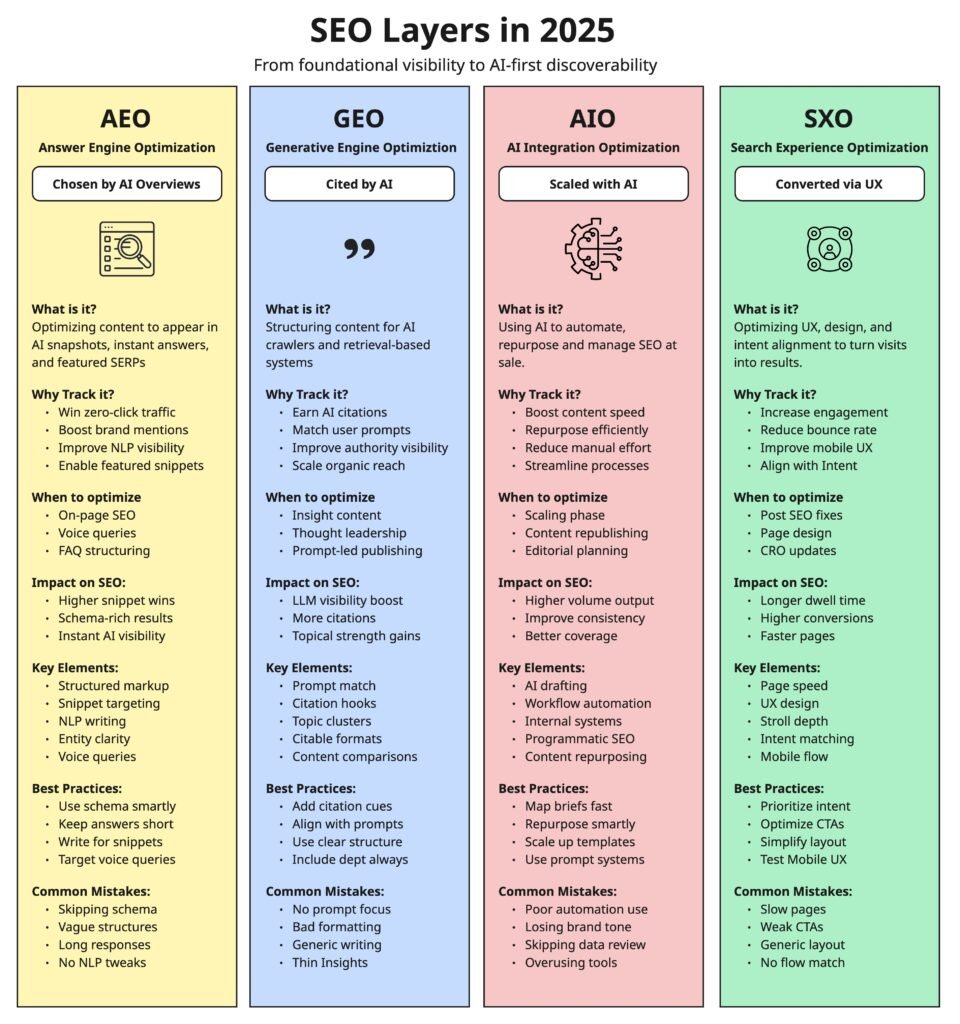Table of Contents
With 30 years of exposure to the internet business, I’ve seen the digital world from its early beginnings through to the current era of artificial intelligence-driven transformation. My latest stint at Home Credit Philippines, where I led the creation of a comprehensive MarTech ecosystem, serves to illustrate the transformative value of integrated platforms.
On www.asiatechbuzz.com, we are passionate about examining the way marketing technology empowers businesses. Today, I am excited to explain how DXP for AI search optimization, exemplified by platforms like Magnolia CMS, Adobe AEM, Sitecore, Optimizely, and Strapi, serves as the cornerstone for content authors and SEO professionals who are leveraging AI-driven searches, such as Google AI Overviews and ChatGPT’s searching capabilities. Adopting DXP for AI search optimization has become vital for achieving success in the evolving digital landscape.
AI searches demand content that is both machine-readable and user-engaging, a challenge traditional Content Management Systems (CMS) struggle to meet. Digital Experience Platforms (DXPs) like Magnolia CMS bridge this gap by serving as a central content hub that integrates with Customer Data Platforms (CDPs) and other MarTech tools to deliver personalized, AI-optimized content.
Drawing from my extensive experience, particularly with Magnolia CMS at Home Credit, this article explores how DXP for AI search optimization empowers teams to excel in Artificial Intelligence Optimization (AIO), Answer Engine Optimization (AEO), Generative Engine Optimization (GEO), and Search Experience Optimization (SXO).
Backed by the latest industry trends and sharing experiences from Home Credit, we’ll uncover why DXPs are indispensable in the AI-driven MarTech ecosystem and offer actionable strategies for marketing professionals, CMOs, and CTOs to stay ahead.
Executive Summary: DXP as the Foundation for AI Search Success
The marketing technology landscape, boasting over 15,000 tools, is a dynamic and complex ecosystem where AI-driven searches – Google AI Overviews, ChatGPT’s conversational queries, and others, are redefining content visibility. DXP for AI search optimization, exemplified by Magnolia CMS, Adobe AEM, Sitecore, Optimizely, and Strapi, is the critical enabler, evolving from traditional CMS to support sophisticated AI strategies.
At Home Credit Philippines, we positioned Magnolia CMS as the core platform to centralize content and distribute it across channels, integrating with tools like mParticle CDP to drive personalized campaigns. DXPs support AIO (machine-readable content), AEO (direct answers), GEO (AI citations), and SXO (seamless user journeys) through headless delivery, CDP integration, and AI tools. Industry trends, such as the projected $26.54 billion DXP market by 2030, highlight their growing importance. For content creators and SEO experts, DXP for AI search optimization ensures consistent, privacy-compliant experiences in the AI-driven MarTech ecosystem, driving competitive advantage and measurable ROI.
Introduction: The AI Search Revolution and DXP’s Pivotal Role
With three decades in the online industry, from pioneering digital campaigns to architecting MarTech ecosystems, I’ve seen technology transform marketing. As we discuss at www.asiatechbuzz.com, AI is reshaping search, with the introduction of Google AI Mode and ChatGPT prioritizing instant, context-aware answers over traditional link lists. This evolution challenges content writers to craft AI-friendly content and SEO specialists to optimize for machine-driven algorithms.
Traditional CMS platforms, designed for web publishing, struggle with omnichannel demands and AI optimization. DXP for AI search optimization, through platforms like Magnolia CMS, addresses these challenges by serving as a central content repository that integrates with CDPs and other MarTech tools to deliver tailored content. For marketing leaders and tech managers, understanding DXP’s role in the AI-driven MarTech ecosystem is essential for driving engagement and ROI.
From CMS to DXP: Evolving for AI Search Optimization
The CMS Era: Strengths and Limitations
Early in my career, CMS platforms like WordPress revolutionized content creation with user-friendly editors, SEO plugins, and collaboration tools. They enabled non-technical teams to publish content, supported mobile templates, and allowed content reuse. At Home Credit Philippines, we initially relied on WordPress CMS for web content but quickly encountered limitations, to evolving to Strapi and eventually Magnolia CMS.
As AI searches like Google AI Overviews makes the situation even more complex, and traditional CMS couldn’t handle unified data or omnichannel delivery, leading to silos. Optimizing for ChatGPT required add-ons, creating complexity. This gap drove us to explore using DXP for AI search optimization, with Magnolia CMS leading as our core platform.
Defining DXP: The AI Search Enabler
DXPs, such as Magnolia CMS, Adobe AEM, Sitecore, Optimizely, and Strapi, go beyond CMS by orchestrating content, data, and interactions across channels. While they don’t provide 360-degree customer insights (a CDP’s role), they excel at using CDP audience data to deliver tailored content. At Home Credit Philippines, we integrated Magnolia CMS with mParticle CDP to distribute personalized content across web, mobile, and email, leveraging audience segments for precision.
In the AI-driven MarTech ecosystem, DXP for AI search optimization offers writers intuitive tools for AI-ready content and SEO pros analytics to align with AI search algorithms, ensuring visibility in platforms like ChatGPT and Google AI Mode.
Core DXP Features for AI Optimization
DXPs such as Magnolia CMS come with capabilities that enable AI search optimization:
- Headless Content Delivery: Magnolia’s headlessness came in handy for our use case at Home Credit, which is suitable for AIO.
- CDP Integration: Integration of Magnolia with mParticle CDP allowed for AEO and GEO content personalization based on audience profiles.
- AI Tools: Magnolia’s AI-based content recommendations automate AIO and AEO workflows, as we’ve learned in campaign planning.
- Analytics: Magnolia’s dashboards track engagement and filter down SXO strategies, such as Optimizely’s features.
- Composable Architecture: Magnolia’s API-first design integrates with MarTech tools like MoEngage and GA4, ensuring agility.
These characteristics render DXP for AI search optimization the foundation for contemporary strategies.
| Feature/Aspect | Content Management System (CMS) | Digital Experience Platform (DXP) |
|---|---|---|
| Core Function | Web content publishing | Omnichannel orchestration with AI |
| Data Handling | Basic metadata | CDP-integrated audience targeting |
| Personalization | Rule-based | AI-driven via CDP insights |
| Integration | Add-ons | API-composable for MarTech |
| Search Focus | Traditional SEO | Potential to customize for AI search optimization |
Mastering AI Search Optimization with Your DXP
In today’s AI-driven world, getting found isn’t just about traditional search rankings anymore. It’s about ensuring your content speaks directly to AI systems, provides instant answers, builds trust, and offers a smooth user journey. This is where a powerful DXP for AI Search Optimization becomes your secret weapon, bringing together several key strategies:

Artificial Intelligence Optimization (AIO): Making Content AI-Ready
Think of Artificial Intelligence Optimization (AIO) as teaching your content to speak “AI.” It’s all about making sure your information is easily understood by AI systems like Google’s large language models (LLMs) and tools like ChatGPT. Unlike traditional SEO, AIO digs deeper, focusing on token efficiency (using words precisely for AI), semantic clarity (making your meaning crystal clear), and effective embeddings (how AI interprets your content’s context). This careful approach dramatically cuts down on AI misinterpretations.
While you might hear about Google AI Overviews – those handy AI-generated summaries at the top of Google searches – AIO is the broader strategy that makes your content machine-friendly for any AI application. By embracing AIO principles, your content is far more likely to be accurately understood and used by these systems, including appearing prominently in those coveted Google AI Overviews.
At Home Credit, our DXP, Magnolia CMS, was essential for implementing AIO. By structuring our content with clear headings and concise formats right within the DXP, we made sure it was not just readable for people but also perfectly set up for AI processing. This made our content a top candidate for AI-driven features like Google AI Overviews.
Answer Engine Optimization (AEO): Delivering Instant Answers
Answer Engine Optimization (AEO) is all about getting your content to provide quick, direct answers to what people are asking, especially through Google AI Overviews and voice searches. Forget simply getting a click to your website; AEO prioritizes instantly solving the user’s need right there in the search results.
We achieve this by using techniques like schema markup – a special code that helps search engines understand your content – and straightforward Q&A formats. This clever structuring helps AI systems immediately match common questions (like “How to optimize for AI search?”) with clear, digestible answers from your content.
Generative Engine Optimization (GEO): Earning AI Trust and Citations
Generative Engine Optimization (GEO) is your strategy for ensuring your content isn’t just seen by AI, but actually cited and recommended by generative AI systems like ChatGPT or Google’s Gemini. The big goal here is to make your content such a trusted source that AI outputs point directly to you, extending your brand’s authority far beyond traditional search.
GEO heavily relies on E-E-A-T (Experience, Expertise, Authoritativeness, and Trustworthiness). This means demonstrating you know your stuff, are a leader in your field, and provide reliable information. It also involves keeping your content fresh and using semantic markup to clarify its meaning. These signals tell AI models that your information is credible and worth recommending.
At Home Credit, our DXP’s (Magnolia CMS) content hub proved invaluable for GEO. It provided a centralized place to manage and publish truly authoritative, up-to-date content for all our campaigns, dramatically increasing the odds of our work being cited as a reliable source by various AI outputs.
SXO: Creating Seamless Post-Search Experiences
Finally, Search Experience Optimization (SXO) is where user experience (UX) and conversion rate optimization (CRO) meet. While AIO, AEO, and GEO get users to your content via AI, SXO ensures that once they click, their journey is incredibly smooth and leads to a desired action. It’s about making sure that AI-driven click turns into something meaningful.
SXO focuses on crucial elements like fast load times – because no one likes waiting – and delivering content that perfectly matches the user’s intent. This approach minimizes frustration and keeps people engaged, guiding them effortlessly towards the next step.
These strategies are interconnected, and DXP for AI search optimization unifies them for holistic success.
| Focus | Key Tactics | AI Search Impact | ||
|---|---|---|---|---|
| AIO | Machine-readable content | AI comprehension | Clear structure, embeddings | Accurate Google AI Overviews |
| AEO | Direct query answers | Instant responses | Schema, Q&A style | Tops ChatGPT/voice results |
| GEO | AI output visibility | Citation authority | E-E-A-T, updates | Cited in generative searches |
| SXO | Search-to-conversion | User satisfaction | UX, speed, intent | Converts AI traffic |
Case Study: Magnolia CMS at Home Credit Philippines
At Home Credit Philippines, I led the implementation of a MarTech ecosystem where Magnolia CMS for AI search optimization served as the core platform to centralize content into a single repository. By leveraging Magnolia’s capabilities, we distributed the right content to the right channel – web, mobile, online channels, and more – ensuring consistency and relevance. Magnolia CMS was integrated into a broader ecosystem, including mParticle CDP for audience segmentation, MoEngage and SAS for customer engagement platforms (CEPs), and Google Analytics 4 (GA4) for performance tracking.
This setup enabled us to create personalized campaigns based on CDP-driven audience insights, boosting engagement by aligning content with user preferences. For example, Magnolia’s headless delivery allowed us to reuse blog posts as snippets and mobile app content, optimizing for AIO by ensuring machine-readable formats. Its schema tools supported AEO, helping us craft FAQ pages that appeared in Google AI Overviews. For GEO, Magnolia’s content hub maintained E-E-A-T-compliant assets, increasing citations in AI-driven searches. SXO was enhanced through Magnolia’s mobile-responsive designs and GA4 insights, reducing bounce rates and driving conversions. This case study underscores how DXP for AI search optimization, with Magnolia CMS at its core, transforms fragmented efforts into cohesive, impactful strategies.
DXP: The Core of AI Search Optimization
In today’s rapidly evolving digital landscape, success hinges on how well your content resonates with artificial intelligence. This is precisely where a robust Digital Experience Platform (DXP) for AI Search Optimization becomes indispensable. Leading DXPs, such as Magnolia CMS, Adobe Experience Manager (AEM), Sitecore, Optimizely, and Strapi, are no longer just content management systems; they are pivotal in enabling marketing and content teams to effectively adapt to and leverage AI-powered platforms like Google AI Overviews (often referred to as Google AI Mode in some contexts) and generative AI models like ChatGPT.
AI Integration: Empowering Content Creation with Your DXP
A modern DXP for AI Search Optimization acts as a central intelligence hub. These platforms are increasingly integrating AI capabilities to analyze vast amounts of customer data from Customer Data Platforms (CDPs), providing writers with actionable insights. Imagine your DXP suggesting optimal structures for Artificial Intelligence Optimization (AIO) or crafting precise answers for Answer Engine Optimization (AEO).
At Home Credit, for instance, Magnolia CMS’s integrated AI tools provided invaluable content recommendations, significantly streamlining our workflows. Similarly, industry leaders like Adobe AEM and Optimizely offer comparable automation features, dramatically enhancing efficiency within the AI-driven MarTech ecosystem. This integration within a DXP for AI Search Optimization empowers teams to work smarter, not just harder.
AIO: Simplifying Machine-Readable Content through Your DXP
To make your content truly “speak” to AI, Artificial Intelligence Optimization (AIO) is paramount, and your DXP for AI Search Optimization is the enabler. Platforms like Magnolia CMS, with their structured editors, are designed to produce token-efficient and semantically clear content—foundational elements for effective AIO.
At Home Credit, we leveraged Magnolia to meticulously create FAQ pages. These were not just human-readable but precisely aligned with the requirements for Google AI Overviews, which ultimately reduced AI interpretation errors and significantly boosted our content’s retrievability. Competitors such as Sitecore and Strapi provide comparable tools within their DXP offerings, underscoring the industry-wide recognition of AIO’s importance within a DXP for AI Search Optimization.
AEO: Crafting Quick Answers with Your DXP
Answer Engine Optimization (AEO) is all about providing direct, instant answers that cut through the noise, especially for platforms driven by AI. A DXP for AI Search Optimization is crucial here. Magnolia’s seamless schema integration and sophisticated query analysis capabilities empowered us at Home Credit to create highly AEO-friendly Q&As for our campaigns.
This ensured our content precisely matched user intent for AI-powered searches, making it more likely to be featured as a direct answer. Adobe AEM and Optimizely also support similar robust features, highlighting how a comprehensive DXP for AI Search Optimization ensures your content delivers immediate value in the answer engine landscape.
GEO: Building Authority for AI Citations through Your DXP
Generative Engine Optimization (GEO) is about establishing your content as an authoritative source, ensuring it gets cited and recommended by generative AI outputs like ChatGPT. Your DXP for AI Search Optimization plays a critical role in this. Magnolia’s robust content hub, for example, enabled Home Credit to maintain extensive, E-E-A-T-compliant (Experience, Expertise, Authoritativeness, and Trustworthiness) content libraries.
Coupled with crawler-friendly setups, this significantly increased our chances of being cited as a trustworthy source by AI models. Sitecore and Strapi offer similar capabilities within their DXPs, demonstrating how a DXP for AI Search Optimization becomes the backbone for building and projecting the authority that AI systems look for.
SXO: Enhancing User Journeys via Your DXP
Finally, Search Experience Optimization (SXO) is the crucial link that converts AI-driven traffic into loyal customers. It’s the strategic blend of user experience (UX) and conversion rate optimization (CRO) that kicks in after someone clicks on an AI-powered search result. A top-tier DXP for AI Search Optimization is vital for this final, critical stage.
At Home Credit, Magnolia’s inherently mobile-responsive designs and seamless CDN integration were instrumental in optimizing load times, ensuring a lightning-fast experience. Furthermore, leveraging GA4 analytics integrated within our DXP allowed us to continually refine our SXO strategies. Similarly, Optimizely and Adobe AEM excel at enhancing user experiences, demonstrating how a DXP for AI Search Optimization transforms AI-driven search traffic into meaningful conversions and loyal customer relationships.
Table Breakdown: DXP Features and Their Enablement of AI Optimization Strategies
| DXP Feature | AIO Enablement | AEO Enablement | GEO Enablement | SXO Enablement |
|---|---|---|---|---|
| 1. Content Tools | Token clarity | Q&A formats | Logical flow | User-friendly layouts |
| 2. CDP Integration | Contextual depth | Intent matching | Engagement data | Personalized journeys |
| 3. AI Engines | Embeddings | Answer suggestions | Authority building | Intent prediction |
| 4. Omnichannel | Consistent delivery | Multi-device answers | Broad visibility | Seamless transitions |
| 5. Performance | Fast retrieval | Quick access | Crawler ease | Low bounce rates |
| 6. Metadata | Disambiguation | Snippet optimization | Citation support | Technical boosts |
1. Content Tools
Content tools in DXPs, such as Magnolia CMS’s visual editors or Sitecore’s content hub, are the foundation for creating and managing digital assets. They enable structured, scannable content that aligns with AI search requirements.
- AIO Enablement: Token Clarity
AIO focuses on making content machine-readable for Large Language Models (LLMs) like those powering Google AI Overviews. DXP content tools, like Magnolia’s structured editors used at Home Credit, ensure token clarity by organizing content into concise, semantically clear formats (e.g., bullet points, headers). This minimizes redundancy and aligns with LLMs’ token-based processing, reducing misinterpretation risks. For example, we structured loan FAQs in Magnolia to be easily parsed by AI, boosting their retrievability. - AEO Enablement: Q&A Formats
AEO aims to provide direct answers for queries in AI-driven searches. Content tools in DXPs like Adobe AEM allow writers to create Q&A formats, such as FAQ pages or conversational snippets. At Home Credit, Magnolia’s templates helped us craft answers like “What are loan repayment options?” that appeared in Google AI Overviews, enhancing visibility. - GEO Enablement: Logical Flow
GEO ensures content is cited in generative AI outputs like ChatGPT responses. DXP tools support logical flow by organizing content hierarchically with clear headings and subheadings. Magnolia’s content hub ensured our Home Credit blog posts followed a coherent structure, making them easier for AI to summarize and cite accurately. - SXO Enablement: User-Friendly Layouts
SXO focuses on post-search user experience. Content tools in DXPs like Optimizely create user-friendly layouts with intuitive navigation and scannable text. At Home Credit, Magnolia’s templates ensured clean, engaging layouts that kept users on-site, reducing bounce rates and driving conversions.
2. CDP Integration
DXPs integrate with Customer Data Platforms (CDPs) like mParticle to leverage audience data, enabling personalized content without providing full 360-degree customer insights (a CDP’s role).
- AIO Enablement: Contextual Depth
AIO requires content to be contextually relevant for AI systems. CDP integration allows DXPs like Magnolia CMS to pull audience segments from mParticle, as we did at Home Credit, to tailor content (e.g., loan offers for specific demographics). This contextual depth ensures AI correctly interprets and retrieves content for relevant queries. - AEO Enablement: Intent Matching
AEO needs content to align with user intent. CDP data helps DXPs like Sitecore match content to specific queries, such as “best savings plan for young professionals.” At Home Credit, mParticle’s audience insights fed into Magnolia CMS enabled us to craft answers matching user needs, boosting AEO performance. - GEO Enablement: Engagement Data
GEO relies on authoritative content. CDP integration provides engagement data, such as user interaction patterns, to refine content relevance. Magnolia’s integration with mParticle at Home Credit helped us prioritize high-engagement topics, strengthening E-E-A-T (Experience, Expertise, Authoritativeness, Trustworthiness) for AI citations. - SXO Enablement: Personalized Journeys
SXO enhances user experiences post-search. CDP-driven personalization in DXPs like Optimizely creates personalized journeys, delivering tailored content based on user profiles. At Home Credit, Magnolia used mParticle data to serve personalized loan pages, increasing conversions.
3. AI Engines
DXPs incorporate AI engines, such as Magnolia’s content recommendation tools or Optimizely’s Opal AI, to automate and enhance content strategies.
- AIO Enablement: Embeddings
AIO relies on semantic embeddings for AI comprehension. AI engines in DXPs generate embeddings by analyzing content context. At Home Credit, Magnolia’s AI suggested structured formats for loan guides, ensuring embeddings aligned with Google AI Overviews’ semantic processing. - AEO Enablement: Answer Suggestions
AEO benefits from AI-driven answer suggestions. Magnolia’s AI tools, used in our Home Credit campaigns, recommended Q&A formats for common queries, streamlining AEO content creation for voice searches and AI overviews. - GEO Enablement: Authority Building
GEO requires authoritative content for AI citations. AI engines in DXPs like Sitecore identify high-authority topics based on engagement data. Magnolia’s AI at Home Credit flagged trending loan topics, helping us build E-E-A-T-compliant content for ChatGPT citations. - SXO Enablement: Intent Prediction
SXO needs content aligned with user intent. AI engines in DXPs like Adobe AEM predict user needs, personalizing experiences. At Home Credit, Magnolia’s AI predicted user preferences, enhancing SXO by serving relevant content to drive engagement.
4. Omnichannel
DXPs enable content delivery across multiple channels—web, mobile, email, voice assistants—ensuring consistency and accessibility.
- AIO Enablement: Consistent Delivery
AIO requires uniform content for AI systems. Omnichannel delivery in DXPs like Magnolia ensures consistent delivery across platforms. At Home Credit, Magnolia’s headless setup delivered loan content uniformly to web and mobile, aiding AIO by maintaining machine-readable consistency. - AEO Enablement: Multi-Device Answers
AEO targets answers across devices. Magnolia’s omnichannel capabilities ensured Home Credit’s FAQs were accessible via voice assistants and mobile apps, optimizing for AEO in AI-driven searches. - GEO Enablement: Broad Visibility
GEO needs content to be widely accessible for AI citations. Broad visibility through omnichannel delivery, as seen in Strapi and Magnolia, ensures content is crawlable across platforms. At Home Credit, Magnolia’s multi-channel distribution increased citation chances in ChatGPT. - SXO Enablement: Seamless Transitions
SXO requires smooth user experiences across devices. Magnolia’s omnichannel delivery at Home Credit ensured seamless transitions, like moving from email to mobile app, enhancing SXO and reducing drop-offs.
5. Performance
DXP performance features, such as CDN integration and mobile optimization, ensure fast, accessible content delivery.
- AIO Enablement: Fast Retrieval
AIO depends on quick AI access to content. Fast retrieval via CDNs in DXPs like Magnolia ensured Home Credit’s content was readily available for Google AI Overviews, improving AIO performance. - AEO Enablement: Quick Access
AEO requires instant answer delivery. Magnolia’s performance optimizations, like image compression, provided quick access to Home Credit’s FAQs, boosting AEO visibility in voice searches. - GEO Enablement: Crawler Ease
GEO benefits from content that AI crawlers can easily access. Crawler ease in DXPs like Sitecore ensures content isn’t blocked by complex JavaScript. Magnolia’s clean sitemaps at Home Credit aided GEO by simplifying crawler access. - SXO Enablement: Low Bounce Rates
SXO focuses on user retention. Low bounce rates are achieved through fast load times and mobile responsiveness in DXPs like Optimizely. At Home Credit, Magnolia’s CDN integration reduced bounce rates, enhancing SXO.
6. Metadata
DXPs support metadata tools, such as schema markup and canonical tags, to enhance content discoverability.
- AIO Enablement: Disambiguation
AIO requires clear metadata to avoid AI misinterpretation. Magnolia’s metadata tools at Home Credit added disambiguation through canonical terms, ensuring accurate AIO for Google AI Overviews. - AEO Enablement: Snippet Optimization
AEO leverages metadata for featured snippets. Magnolia’s schema markup, used in Home Credit’s FAQs, enabled snippet optimization, boosting AEO visibility in AI searches. - GEO Enablement: Citation Support
GEO relies on metadata for AI citations. Magnolia’s article markup at Home Credit provided citation support, increasing ChatGPT citation likelihood by clarifying authorship and context. - SXO Enablement: Technical Boosts
SXO benefits from technical SEO enhancements. Metadata tools in DXPs like Adobe AEM, including Magnolia’s sitemap generation, provided technical boosts at Home Credit, improving SXO rankings and user experience.
MarTech Trends Fueling DXP Adoption
Here’s a snapshot of 2025 trends highlighting the importance of DXP for AI search optimization:
| Statistics / Trend | Description | Source |
|---|---|---|
| MarTech Tools | 15,384 tools in 2025, up 2,489 from 2024, driven by AI innovations. | MarTech.org |
| MarTech Market | USD 670 billion in 2025, 31.5% growth since 2023. | SMB Guide |
| DXP Market | USD 16.05 billion in 2025, projected to USD 26.54 billion by 2030 (10.58% CAGR). | Mordor Intelligence |
| AI Adoption | 88% of marketers use AI daily, with 56% reporting company-wide implementation. | SurveyMonkey |
| AI Market | USD 47.32 billion in 2025, growing to USD 107.5 billion by 2028 (36.6% CAGR). | SEO.com |
| Generative AI | 68.6% of organizations use generative AI, key for GEO strategies. | MarTech.org |
| AI Search Trends | AIO, AEO, GEO, SXO dominate 2025 strategies for AI-driven visibility. | GVN Marketing |
| MarTech Challenges | 61% cite cost as top issue, driving unified DXP adoption. | Ascend2 |
Strategic Moves: Future-Proofing with DXP
Composable DXPs for Flexibility
Silos hinder efficiency; composable DXPs like Magnolia CMS integrate AI tools quikcly, as we did at Home Credit Phillippines, ensuring agility for AI search updates. Magnolia CMS comes with AI accelerator that allow us to quickly connect to ChatGPT and store AI Prompts by templates.
Privacy-First Data with CDP Integration
With cookie phase-out, DXPs leverage CDP datas for compliant personalization. At Home Credit Philippines, Magnolia and mParticle ensured GDPR / CCPA compliance, building trust.
Overcoming Adoption Hurdles
Skill gaps require training on DXP features like Magnolia’s AI tools. Start with AEO for quick wins, scaling to GEO and SXO. Ethical AI practices ensure long-term success.
Conclusion: DXP as Your AI Search Powerhouse
In the AI-driven MarTech ecosystem, DXP for AI search optimization, with platforms like Magnolia CMS, Adobe AEM, Sitecore, Optimizely, and Strapi, is the key to thriving. My experience at Home Credit showed how Magnolia centralized content and powered AI strategies, delivering impactful results. Visit www.asiatechbuzz.com for more insights on leveraging DXPs.
Recommendations to empower you in your AI search optimization
- Adopt a DXP like Magnolia CMS to unify AI content optimization.
- Train teams on AIO and AEO techniques to align with AI searches.
- Leverage CDP data for. GEO and SXO personalization.
- Optimize for speed and mobile to enhance SXO performance.
- Monitor AI search trends quarterly to stay ahead of the game.
- Pilot AEO projects, scaling to comprehensive strategies.
FAQs: DXP and AI Search Optimization
-
What is DXP for AI Search Optimization?
It’s using platforms like Magnolia CMS to create content optimized for AI-driven searches like Google AI Overviews, supporting AIO, AEO, GEO and SXO.
-
How does DXP differ from CMS for AI searches?
CMS focuses on web content, while DXPs like Sitecore integrate CDP data for AI-driven personalization and omnichannel delivery.
-
How does Magnolia CMS support AIO and GEO?
Magnolia structures content for machine readability (AIO) and builds E-E-A-T for AI citations (GEO), enhancing visibility.
-
Can content writers use DXP without technical expertise?
Yes, Magnolia’s intuitive editors and AI suggestions simplify optimization for non-technical users.
-
How does DXP ensure privacy in the AI-driven MarTech ecosystem?
By integrating with CDPs like mParticle, DXPs ensure compliant, personalized experiences using first-party data.










